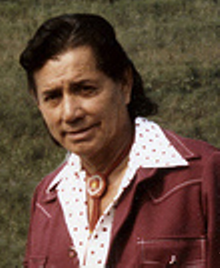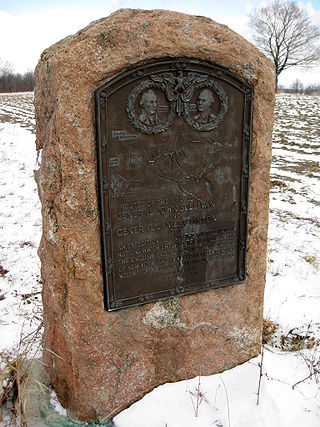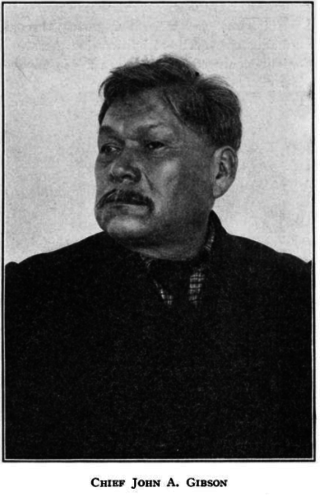
Jay Silverheels was an Indigenous Canadian actor and athlete. He was well known for his role as Tonto, the Native American companion of the Lone Ranger in the American Western television series The Lone Ranger.

The 1779 Sullivan Expedition was a United States military campaign during the American Revolutionary War, lasting from June to October 1779, against the four British-allied nations of the Iroquois. The campaign was ordered by George Washington in response to the 1778 Iroquois and British attacks on the Wyoming Valley, German Flatts, and Cherry Valley. The campaign had the aim of "taking the war home to the enemy to break their morale." The Continental Army carried out a scorched-earth campaign in the territory of the Iroquois Confederacy in what is now western and central New York.
The Seneca are a group of Indigenous Iroquoian-speaking people who historically lived south of Lake Ontario, one of the five Great Lakes in North America. Their nation was the farthest to the west within the Six Nations or Iroquois League (Haudenosaunee) in New York before the American Revolution. For this reason, they are called “The Keepers of the Western Door.”

The Onondaga people are one of the five original nations of the Haudenosaunee (Iroquois) Confederacy in the Northeastern Woodlands. Their historical homelands are in and around present-day Onondaga County, New York, south of Lake Ontario.

Onondaga Lake is a lake in Central New York, immediately northwest of and adjacent to Syracuse, New York. The southeastern end of the lake and the southwestern shore abut industrial areas and expressways; the northeastern shore and northwestern end border a series of parks and museums.

Six Nations is demographically the largest First Nations reserve in Canada. As of the end of 2017, it has a total of 27,276 members, 12,848 of whom live on the reserve. These nations are the Mohawk, Cayuga, Onondaga, Oneida, Seneca and Tuscarora. Some Lenape live in the territory as well.

The Treaty of Canandaigua, also known as the Pickering Treaty and the Calico Treaty, is a treaty signed after the American Revolutionary War between the Grand Council of the Six Nations and President George Washington representing the United States of America.

The Two Row Wampum Treaty, also known as Guswenta or Kaswentha and as the Tawagonshi Agreement of 1613 or the Tawagonshi Treaty, is a mutual treaty agreement, made in 1613 between representatives of the Five Nations of the Haudenosaunee and representatives of the Dutch government in what is now upstate New York. The agreement is considered by the Haudenosaunee to be the basis of all of their subsequent treaties with European and North American governments, and the citizens of those nations, including the Covenant Chain treaty with the British in 1677 and the Treaty of Canandaigua with the United States in 1794.

Otto the Orange is the mascot for the Syracuse Orange, the athletic teams of Syracuse University in Syracuse, New York, USA. Otto is an anthropomorphism of the color orange, wearing a large blue hat and blue pants. Otto can often be seen at Syracuse sporting events in the JMA Wireless Dome and other venues.

The Iroquois, also known as the Five Nations, and later as the Six Nations from 1722 onwards; alternatively referred to by the endonym Haudenosaunee are an Iroquoian-speaking confederacy of Native Americans and First Nations peoples in northeast North America. They were known by the French during the colonial years as the Iroquois League, and later as the Iroquois Confederacy, while the English simply called them the "Five Nations". The peoples of the Iroquois included the Mohawk, Oneida, Onondaga, Cayuga, and Seneca. After 1722, the Iroquoian-speaking Tuscarora people from the southeast were accepted into the confederacy, from which point it was known as the "Six Nations".

Tadodaho was a Native American Hoyenah (sachem) of the Onondaga nation before the Deganawidah and Hiawatha formed the Iroquois League. According to oral tradition, he had extraordinary characteristics and was widely feared, but he was persuaded to support the confederacy of the Five Nations.
Virginia Driving Hawk Sneve is a Native American author, with a focus on children's books about Native Americans.
John Mohawk was an American historian, writer, and social activist.
Lyle Thompson is a Haudenosaunee professional lacrosse player from the Hawk Clan of the Onondaga Confederacy of the Six Nations of the Grand River. His native name is 'Deyhahsanoondey', which translates into 'He's Flying Over Us'. He plays both indoor and outdoor professional lacrosse. In professional outdoor lacrosse, he plays at the attack position for the Cannons Lacrosse Club of the Premier Lacrosse League. In professional indoor lacrosse, he plays at the forward position for the Georgia Swarm of the National Lacrosse League. He also competes internationally in both indoor lacrosse for Haudenosaunee men's national indoor lacrosse team, and outdoor lacrosse for the Haudenosaunee men's national outdoor lacrosse team.
First Nations Lacrosse Association is the governing body of lacrosse for First Nations within Canada and Native American tribes within the United States.

John Arthur Gibson (1850–1912) was a chief of the Seneca nation of the North American Iroquois confederation. Part Onondaga and part Seneca, he resided within the reserve of the Six Nations of the Grand River in Ontario, Canada. Knowledgeable about Iroquois (Haudosaunee) culture, he is best known for the versions he provided of the Iroquois oral constitution, the Great Law of Peace. He acted as an advisor to the Canadian Department of Indian Affairs in matters relating both to Iroquois and non-Iroquois indigenous people. He was a well-respected player of the traditional Iroquois sport of lacrosse until he was blinded during a game when he was 31.

The Haudenosaunee Nationals Men’s Lacrosse Team, formerly known as the Iroquois Nationals, represents the Iroquois Confederacy in international field lacrosse competition. They are currently ranked third in the world by World Lacrosse after winning Bronze at the 2018 World Lacrosse Championship.
Tonya Gonnella Frichner was an American activist and lawyer, known for her Indigenous international work, particularly for her contributions to the United Nations Declaration on the Rights of Indigenous Peoples.

The flag of the Iroquois Confederacy or Haudenosaunee flag is the flag used to represent the six nations of the Iroquois. It is a purple flag with four connected white squares and an eastern white pine tree in the center.
Leon Shenandoah was an Onondaga politician who headed the Haudenosaunee (Iroquois) Confederacy from 1968 to his death.












